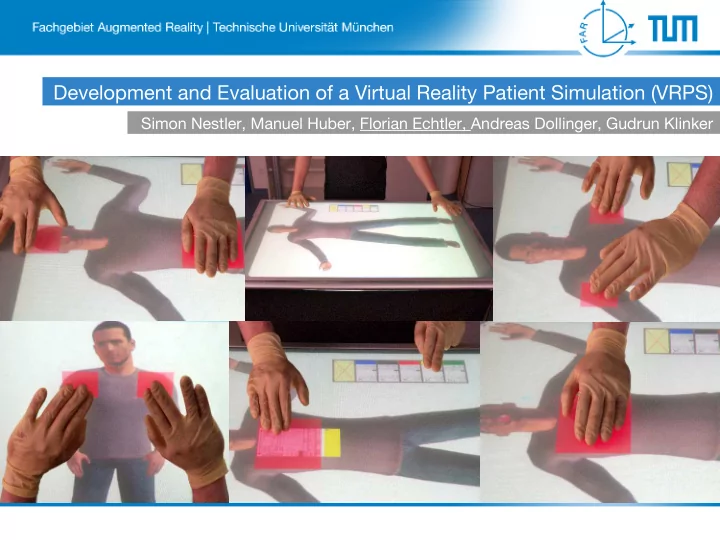

Development and Evaluation of a Virtual Reality Patient Simulation (VRPS) Simon Nestler, Manuel Huber, Florian Echtler, Andreas Dollinger, Gudrun Klinker
Introduction During disasters, paramedics cope with numerous tasks - Establishing organizational structures - Triaging all involved patients (45s per patient) - Medicating the patients according to their injuries NATO Triage Standard Triage category Treatment T1 Immediate Treatment T2 Delayed Treatment T3 Minimal Treatment T4 Expectant Treatment Development and Evaluation of a Virtual Reality Patient Simulation 2
Introduction Germany Germany Germany Triage by doctors Triage Triage Munich by doctors by paramedics Triage by paramedics 2006 Present day ? Triage based on the mSTaRT-algorithm: - Check whether the patient is able to walk - Test the patient for deadly injuries - Check and count out breathing rate - Apply compression bandages on serious bleedings - Feel the patient’s peripheral pulse - Check if the patient is awake and responsive K. Kanz, P. Hornburger, M. Kay, W. Mutschler and W. Schäuble: mSTaRT-Algorithmus für Sichtung, Behandlung und Transport bei einem Massenanfall von Verletzten , Notfall Rettungsmed. (2006) 264-270 Development and Evaluation of a Virtual Reality Patient Simulation 3
Motivation Recent introduction of new triage procedures requires intensive and continuous training Large scale disaster control exercises are expensive and laborious Smaller trainings offer only limited training possibilities Triage trainings have to be optimized regarding.. - Affordability (number of exercise actors) - Intensity (number of triage processes) Affordability - Realism (actor make-up, environment) Intensity Realism Development and Evaluation of a Virtual Reality Patient Simulation 4
Motivation Advantages of computer-based triage trainings: - Low lead time - Scalable - No actors required - No organisational overhead Advantages of multi-touch table top interfaces: - Intuitive interaction - Two-handed interaction - Collaborative interaction Development and Evaluation of a Virtual Reality Patient Simulation 5
Designing virtual patients Gutsch et al. presented a desktop computer-based triage simulation For continuous training of paramedics their approach is insufficient: - No collaboration - No interaction metaphors - “Multiple-choice” training - No two-hand interactions - No possibility to make mistakes W. Gutsch, T. Huppertz, C. Zollner, P. Hornburger, M. Kay, U. Kreimeier, W. Schäuble and K. Kanz: Initiale Sichtung durch Rettungsassistenten . Notfall Rettungsmed., 9(4):384-388, 2006. Development and Evaluation of a Virtual Reality Patient Simulation 6
Technical background Multi-touch technologies have first been presented by Lee et al. Our multi-touch table top is based on the technology of Jeff Han Multi-touch sensing through frustrated total internal reflection S. Lee, W. Buxton and K. Smith: A multi-touch three dimensional touchsensitive tablet . In CHI '85: Proceedings of the ACM Human Factors in Computing Systems Conference, San Francisco, California, USA, 1985. J. Han. Low-cost multi-touch sensing through frustrated total internal reflection . In UIST '05: Proceedings of the 18th annual ACM symposium on User interface software and technology, pages 115-118, New York, NY, USA, 2005. Development and Evaluation of a Virtual Reality Patient Simulation 7 7
Implementation - Removing foreign bodies - Performing the head tilt-chin lift manoeuvre and looking for foreign bodies - Checking the patients’ breathing Paramedics are familiar with the basic procedures Red boxes are not visible during triage training Development and Evaluation of a Virtual Reality Patient Simulation 8
Implementation Changing patient position - Propping up the patient - Putting down the patient Development and Evaluation of a Virtual Reality Patient Simulation
Implementation Allocation of coloured patient tags - Select patient tag (hand 1) - Apply it to the patient (hand 2) Development and Evaluation of a Virtual Reality Patient Simulation 10
Patient model General behaviour of patients can be described by state machines General interactions - Touch - Check breathing - Take pulse - Check bleeding - Assign card Development and Evaluation of a Virtual Reality Patient Simulation 11
Patient patterns Concrete patient information is contained in specific patient patterns (= additional state transitions) More than 300 different patient patterns have been designed by the fire department Munich Patient model and patient patterns have to be combined, resulting in a single large state machine Development and Evaluation of a Virtual Reality Patient Simulation 12
Evaluation Comparison to real-life triage trainings: time per triage process Average time for one triage process is about half as long as in real disaster control exercises (22s vs. 41s) W. Gutsch, T. Huppertz, C. Zollner, P. Hornburger, M. Kay, U. Kreimeier, W. Schäuble and K. Kanz: Initiale Sichtung durch Rettungsassistenten . Notfall Rettungsmed., 9(4):384-388, 2006. Development and Evaluation of a Virtual Reality Patient Simulation 13
Evaluation Quality of triage processes Comparision of results to real-life triage trainings In the real-life disaster control exercise about 85 percent of all patients were triaged correctly, in the table top training 89 percent of all patients were triaged correctly => no significant difference. W. Gutsch, T. Huppertz, C. Zollner, P. Hornburger, M. Kay, U. Kreimeier, W. Schäuble and K. Kanz: Initiale Sichtung durch Rettungsassistenten . Notfall Rettungsmed., 9(4):384-388, 2006. Development and Evaluation of a Virtual Reality Patient Simulation 14
Conclusion and future work VRPS does not prevent inaccurate triage decisions Retaining the possibility to make errors is important Table top device is adequate to be used in disaster control exercises More frequent trainings of the paramedics can improve preparedness for real disasters Training effects will be the topic of our future work Three groups of paramedics: the first group trains on the table top, the second one performs no training and the third one trains with real mimes Acknowledgements: Mr. Tretschok Paramedics from Munich fire department Development and Evaluation of a Virtual Reality Patient Simulation 15
Recommend
More recommend